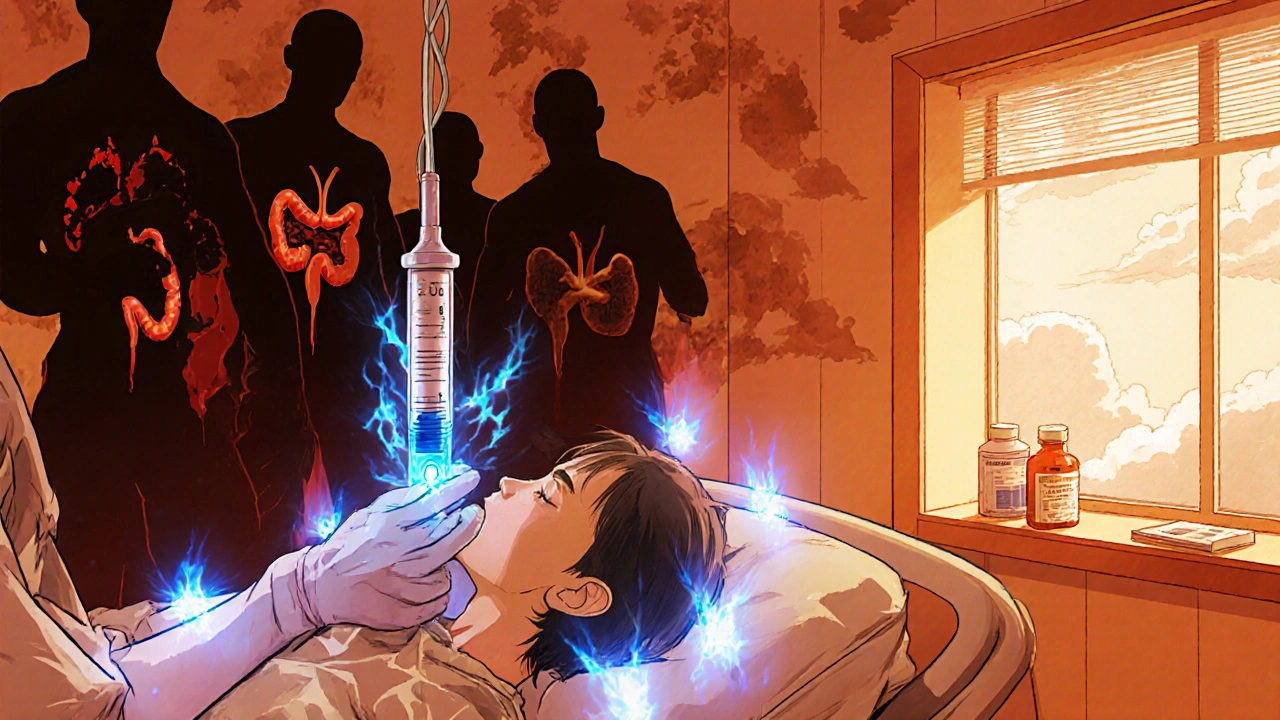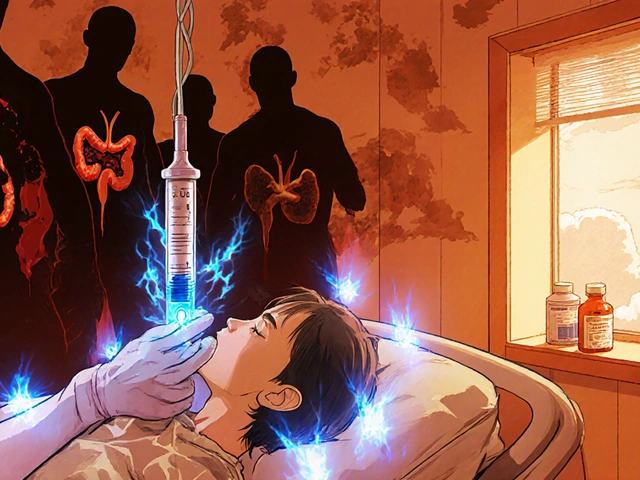Toradol (ketorolac) is a powerful NSAID used for short-term relief of moderate to severe pain-often after surgery or serious injury. But it’s not the only option. Many people wonder: is Toradol the best choice, or are there safer, just-as-effective alternatives? The answer depends on your pain level, medical history, and how long you need relief.
What Toradol (Ketorolac) Actually Does
Toradol works by blocking enzymes that cause inflammation and pain. It’s stronger than ibuprofen or naproxen and acts faster. That’s why hospitals and ERs use it for acute pain: broken bones, dental surgery, post-op recovery. But it’s not meant for daily use. The FDA limits Toradol to 5 days max because of serious risks: stomach ulcers, kidney damage, and bleeding.
It’s not an opioid, so it doesn’t cause addiction or respiratory depression. But it’s still risky if you have high blood pressure, kidney disease, or are over 65. If you’ve ever had a stomach bleed from NSAIDs, Toradol could be dangerous.
Common Alternatives to Toradol
There are several options that can replace Toradol depending on your situation. Here are the most common ones:
- Ibuprofen (Advil, Motrin) - Over-the-counter, good for mild to moderate pain. Safer for long-term use than Toradol, but weaker.
- Naproxen (Aleve, Naprosyn) - Lasts longer than ibuprofen. Better for ongoing inflammation like arthritis. Still carries NSAID risks, but lower dose = lower risk.
- Acetaminophen (Tylenol) - Not an NSAID. No anti-inflammatory effect, but safe for stomach and kidneys if used correctly. Great for people who can’t take NSAIDs.
- Celecoxib (Celebrex) - A COX-2 inhibitor. Less stomach irritation than traditional NSAIDs. Used for chronic pain like osteoarthritis. Still not safe for heart patients.
- Tramadol - A weak opioid. Used when NSAIDs aren’t enough. Lower addiction risk than oxycodone, but still carries dependence potential.
- Morphine or Oxycodone - Strong opioids. Reserved for severe pain when nothing else works. High risk of addiction, constipation, drowsiness.
Toradol vs. Ibuprofen: Which Is Better?
For most people with everyday pain-headache, muscle strain, menstrual cramps-ibuprofen is the smarter pick. It’s cheaper, available without a prescription, and has a much better safety profile.
Toradol is about 4-5 times stronger than ibuprofen in pain relief studies. But that doesn’t mean it’s better. In a 2023 study of post-surgical patients, Toradol gave slightly faster pain relief in the first 2 hours. But after 24 hours, ibuprofen worked just as well with far fewer side effects.
Use Toradol only if you need strong, fast pain control for a few days. Use ibuprofen if you’re managing pain long-term or don’t have access to a doctor’s prescription.
Toradol vs. Acetaminophen: The Safety Showdown
If your biggest concern is stomach bleeding or kidney damage, acetaminophen wins. It doesn’t irritate the gut or affect kidney blood flow like NSAIDs do. That’s why doctors often recommend it for older adults or people with kidney disease.
But here’s the catch: acetaminophen doesn’t reduce inflammation. If your pain comes from swelling-like a sprained ankle or tendonitis-it won’t help as much as Toradol. It’s also easy to overdose on. More than 4,000 mg per day can cause liver failure. That’s why you need to check every pill, cold medicine, and supplement you take.
For mild pain with no inflammation, acetaminophen is safer. For moderate to severe pain with swelling, Toradol is stronger-but only for a few days.

When to Consider Celecoxib or Tramadol
Celecoxib is a good middle ground if you need daily pain relief and have a history of stomach issues. It’s less likely to cause ulcers than Toradol or naproxen. But it’s expensive, and if you have heart disease, it’s not recommended. Studies show it raises the risk of heart attack in people with existing conditions.
Tramadol is an option when NSAIDs aren’t enough but you want to avoid strong opioids. It’s used for moderate to severe pain that lasts longer than a few days. It’s not as powerful as oxycodone, but it still carries a risk of dependence. Withdrawal symptoms can include anxiety, sweating, and insomnia.
Neither Celecoxib nor Tramadol should be your first choice unless Toradol is off the table due to your health history.
When Opioids Might Be Necessary
For severe trauma, major surgery, or cancer pain, opioids like morphine or oxycodone may be unavoidable. But they’re not better than Toradol for most short-term pain. In fact, a 2024 Johns Hopkins study found that patients given Toradol after minor orthopedic surgery needed fewer opioids and had fewer side effects like nausea and constipation.
Opioids should only be used when other options fail-and even then, for the shortest time possible. The CDC recommends avoiding opioids for acute pain unless the pain is extreme and unresponsive to NSAIDs or acetaminophen.
Who Should Avoid Toradol Altogether?
Toradol isn’t safe for everyone. Avoid it if you:
- Have had a stomach ulcer or bleeding
- Have kidney disease or are on dialysis
- Are over 65 (higher risk of kidney and GI problems)
- Have heart failure or high blood pressure
- Are pregnant (especially in the third trimester)
- Are taking blood thinners like warfarin or aspirin
- Have asthma worsened by NSAIDs
If any of these apply to you, talk to your doctor about alternatives. Acetaminophen, physical therapy, or even nerve blocks might be safer.

Practical Tips for Choosing the Right Pain Relief
Here’s how to pick the best option for your situation:
- Mild pain, no swelling? Try acetaminophen first. Safe, cheap, and effective.
- Mild to moderate pain with swelling? Ibuprofen or naproxen. Take the lowest dose that works.
- Severe pain after surgery? Toradol for 1-3 days only. Then switch to ibuprofen or acetaminophen.
- Chronic pain, stomach issues? Talk to your doctor about celecoxib or non-drug options like physical therapy.
- Pain not improving? Don’t increase the dose. See your doctor. You might need a different diagnosis.
Never mix NSAIDs. Don’t take Toradol with ibuprofen or naproxen. That doubles your risk of bleeding and kidney damage.
Final Takeaway: Toradol Has a Place-But Only a Short One
Toradol is a powerful tool, but it’s not a long-term solution. It’s like a fire extinguisher: great in an emergency, dangerous if you use it every day. For most people, safer, equally effective alternatives exist.
If you’ve been prescribed Toradol, ask: How long do I really need this? Can I switch to ibuprofen or acetaminophen in a few days? Are there non-drug options like ice, rest, or physical therapy?
The goal isn’t just to kill the pain. It’s to manage it safely-so you heal without new problems.
Is Toradol stronger than ibuprofen?
Yes, Toradol is significantly stronger than ibuprofen. In clinical studies, a single 10 mg dose of ketorolac provides pain relief similar to 400-600 mg of ibuprofen. But that doesn’t mean it’s better. Toradol carries much higher risks of stomach bleeding and kidney damage, so it’s only approved for short-term use (up to 5 days). Ibuprofen is safer for everyday or long-term pain.
Can I take Tylenol with Toradol?
Yes, you can safely take acetaminophen (Tylenol) with Toradol. They work in different ways-Toradol reduces inflammation, Tylenol affects pain signals in the brain. Many doctors recommend combining them for better pain control with lower doses of each drug. Just make sure you don’t exceed 3,000-4,000 mg of acetaminophen per day to avoid liver damage.
Does Toradol make you sleepy?
Toradol doesn’t typically cause drowsiness like opioids or sedatives. But some people report feeling lightheaded, dizzy, or tired-especially if they’re dehydrated or taking it with other medications. If you feel unusually sleepy after taking Toradol, avoid driving or operating machinery and talk to your doctor.
What’s the safest long-term painkiller?
For long-term pain, there’s no single safest option-it depends on your health. Acetaminophen is safest for the stomach and kidneys if used within limits (under 3,000 mg/day). For inflammatory pain like arthritis, low-dose naproxen or celecoxib may be better. Non-drug options like physical therapy, weight management, and heat/cold therapy are often the safest and most effective over time.
Why is Toradol only for 5 days?
Toradol is limited to 5 days because prolonged use sharply increases the risk of serious side effects: internal bleeding, kidney failure, and heart problems. Studies show that after 5 days, the risk of complications rises dramatically without added pain relief benefits. That’s why it’s designed for acute, short-term pain-like after surgery-not for chronic conditions like back pain or arthritis.
Can I get Toradol over the counter?
No, Toradol is only available by prescription in the U.S. and most other countries. Even though it’s an NSAID, its potency and risk profile make it too dangerous for over-the-counter use. You’ll need a doctor’s evaluation before getting it.
What to Do Next
If you’re currently using Toradol, don’t stop suddenly-talk to your doctor about tapering or switching. If you’re considering it for pain, ask: Is this the right tool for my situation? Could a safer, longer-term option work just as well?
Pain management isn’t about finding the strongest drug. It’s about finding the right one-safe, effective, and sustainable. Toradol has its role. But for most people, better, safer choices exist.







Write a comment
Your email address will be restricted to us